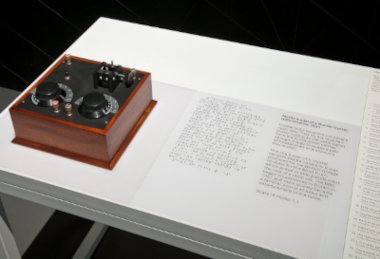3 October 2024
Tactile diagrams – how they are made and used
by Dave Horwood
Whether you need a graph to accompany a scientific article, a map of your local neighbourhood or a tactile image of the solar system, we can help!
Read on to find out how we produce our tactile products here at A2i and what other methods are available for creating tactile information.
How we produce tactile products at A2i
To produce our tactile diagrams, we use a special type of swell paper that’s placed in a machine that heats up the paper.
Firstly, the master diagram is designed in black and white. We adapt the original diagram, to make sure there isn’t too much cluttered information which could be difficult to understand by touch. We follow a variety of rules and guidelines to make sure the diagram is user-friendly and easy to use.
The black and white image is then printed onto the swell paper using a normal printer, before we pass the paper through a specialised heat machine. The black ink reacts with the heat and forms raised lines and areas that the user can feel. The available textures are versatile e.g. a grainy, sand type texture (often used to represent the sea on maps) and lines of various thicknesses, that can be smooth or bumpy, (useful for representing different values on a graph). The reverse side of the swell paper is smooth and is not used for tactile information.
Other ways to produce tactile diagrams
My first introduction to tactile diagrams was at school where along with swell paper, I used Wikki Stix and a type of thin plastic film. Using the plastic film, you can produce raised lines when a pen or other sharp object presses on the surface. The drawback is there is no way to rub out or delete what you’ve already drawn, which isn’t great for an indecisive person like me. Wikki Stix are great fun and were a sure-fire way to get my sighted friends involved. Essentially, they are thin strips of yarn covered in wax and they can be stuck to paper, card or even the table to make shapes and diagrams. It is quite easy to bend Wikki Stix into the shape you want, but sadly the previous version was discontinued where you could pull the sticks apart by hand, so always make sure you have some scissors close by.
Tactile diagrams in the outside world
We all like to take a break from everyday life sometimes but going on holiday as a visually impaired person can be exhausting, having to learn new routes and the layout of the building or campsite where you’re staying.
Any extra information about the local area I can learn is very useful. Center Parcs have won accessibility awards for providing Braille map handouts and large orientation map boards in Braille and Large Print, as well as general guest information in both formats.
Another thing to consider is whether a tourist attraction will be interesting and stimulating enough for visually impaired visitors. The Science Museum and the Victoria & Albert museum take a multi-facetted approach to tactile access, providing:
- books containing tactile representations of objects on display
- replica models of precious/delicate objects which are designed to be as life-like as possible
- audio information that can be listened to on a smartphone and can also guide the visitor around the gallery space
- Braille and Large Print information displayed next to objects
Please note: A2i did not produce the accessible formats for the venues mentioned above.
The future of tactile information
One of the biggest issues with tactile diagrams has been accessing them and producing them quickly, especially if you don’t have enough sight to edit the image before it’s raised or have no way of knowing what the visual image actually contains. There are some ground-breaking refreshable Braille displays and tablets on the market nowadays which aim to reduce these barriers. Whilst the costs are still quite high, companies have been pushing the boundaries with the number of braille cells available, on multiple lines, so tactile graphics can be produced for the first time.
In this video Ed from Bristol Braille demonstrates an interactive map of central Bristol made from Braille cells.
3d printing has also become a more affordable option for producing tactile diagrams. Here is a free library from AllAble containing tactile images that you can 3d print yourself
If you have any queries about our tactile products then please don’t hesitate to get in touch.
You can send us an email: info@a2i.co.uk
fill out our online form
or call our telephone: 01179 44 00 44
You can also find our social media here:
Twitter: @A2iTranscribes
LinkedIn: a2i-transcription-services
Instagram: a2itranscription
YouTube: @a2itranscription

